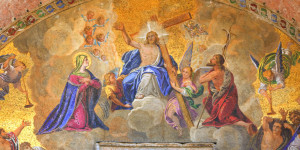Thoughts on Today’s Lessons for April 5, 2015
First Reading: Isaiah 25:6-9“Christ our Passover is sacrificed for us; Therefore let us keep the feast.” Amid the joy of the Resurrection and Easter Day, this joyous affirmation that we utter at every Eucharist echoes the Prophet Isaiah, who imagines a sumptuous feast set out for all God’s people as a celebration of victory over death. Isaiah saw the feast in the context of Israel’s return from exile; we understand it as God’s saving grace through Jesus. All together praise God in gladness and rejoice in God’s salvation.
Psalm: Psalm 118:1-2, 14-24
We can feel a sense of Easter joy in today’s Psalm (which overlaps substantially with last week’s Palm Sunday Psalm). Christians should take note that this is also a Psalm used to celebrate Passover. It sings of joy blended with gratitude. We are overjoyed at our salvation; we are delighted at our victory over death; and we are grateful for God’s goodness and mercy. God has heard our prayers and responded, laying a new cornerstone for a just world. This is the day that the Lord has made: Let us rejoice and be glad!
Alternate First Reading or Second Reading: Acts 10:34-43
These verses from Acts, the Evangelist Luke’s account of the life of the early church, tell us that salvation through Jesus’ life, death on the cross and resurrection is meant for everyone. Peter, speaking to the family of the Roman Centurion Cornelius, declares that God’s Good News in the Gospel shows no partiality. Forgiveness of our sins through God’s saving grace is given to every nation, to all the people, to Jew and Gentile alike: Jesus is Lord of all..
Alternate Second Reading: 1 Corinthians 15:1-11
As Paul’s first letter to the Corinthians draws toward its close, he speaks of the centrality of the Resurrection to Christian belief. All who witnessed the risen Christ, he writes – including Paul himself, remembering his vision on the road to Damascus – now proclaim to the whole world that God’s saving grace comes to us through the crucifixion and the Resurrection.
Gospel: Mark 16:1-8
Here is the story of Easter morning as told by Mark, the earliest of the Gospels. It is sunrise, and three grieving women get up early to take spices to the tomb to anoint Jesus’ beloved body. When they get there, they find that the stone has rolled away from the door! A young man dressed in white tells them, “He has been raised; he is not here. … he is going ahead of you to Galilee; there you will see him, just as he told you.” It’s not surprising that they were terrified. They ran away and told no one. And just like that, the original version of Mark’s Gospel ends, leaving us to wonder what comes next.
Alternate Gospel: John 20:1-18
Each of the four Gospels’ accounts of the resurrection is slightly different. John’s story gives particular attention to Mary Magdalene. It presents her in beautifully tender verses as the one who remained at the empty tomb after the others had left; the first person to witness the risen Christ, and the one sent to proclaim the good news of his resurrection to the rest. In a narrative similar to other accounts of mysterious appearances, she did not recognize Jesus until he called her name.

